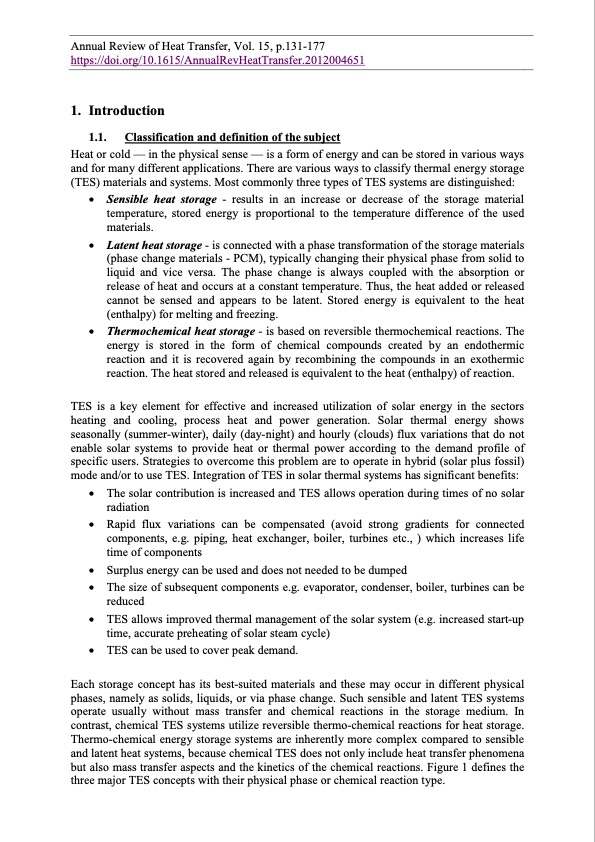
PDF Publication Title:
Text from PDF Page: 003
Annual Review of Heat Transfer, Vol. 15, p.131-177 https://doi.org/10.1615/AnnualRevHeatTransfer.2012004651 1. Introduction 1.1. Classification and definition of the subject Heat or cold — in the physical sense — is a form of energy and can be stored in various ways and for many different applications. There are various ways to classify thermal energy storage (TES) materials and systems. Most commonly three types of TES systems are distinguished: Sensible heat storage - results in an increase or decrease of the storage material temperature, stored energy is proportional to the temperature difference of the used materials. Latent heat storage - is connected with a phase transformation of the storage materials (phase change materials - PCM), typically changing their physical phase from solid to liquid and vice versa. The phase change is always coupled with the absorption or release of heat and occurs at a constant temperature. Thus, the heat added or released cannot be sensed and appears to be latent. Stored energy is equivalent to the heat (enthalpy) for melting and freezing. Thermochemical heat storage - is based on reversible thermochemical reactions. The energy is stored in the form of chemical compounds created by an endothermic reaction and it is recovered again by recombining the compounds in an exothermic reaction. The heat stored and released is equivalent to the heat (enthalpy) of reaction. TES is a key element for effective and increased utilization of solar energy in the sectors heating and cooling, process heat and power generation. Solar thermal energy shows seasonally (summer-winter), daily (day-night) and hourly (clouds) flux variations that do not enable solar systems to provide heat or thermal power according to the demand profile of specific users. Strategies to overcome this problem are to operate in hybrid (solar plus fossil) mode and/or to use TES. Integration of TES in solar thermal systems has significant benefits: The solar contribution is increased and TES allows operation during times of no solar radiation Rapid flux variations can be compensated (avoid strong gradients for connected components, e.g. piping, heat exchanger, boiler, turbines etc., ) which increases life time of components Surplus energy can be used and does not needed to be dumped The size of subsequent components e.g. evaporator, condenser, boiler, turbines can be reduced TES allows improved thermal management of the solar system (e.g. increased start-up time, accurate preheating of solar steam cycle) TES can be used to cover peak demand. Each storage concept has its best-suited materials and these may occur in different physical phases, namely as solids, liquids, or via phase change. Such sensible and latent TES systems operate usually without mass transfer and chemical reactions in the storage medium. In contrast, chemical TES systems utilize reversible thermo-chemical reactions for heat storage. Thermo-chemical energy storage systems are inherently more complex compared to sensible and latent heat systems, because chemical TES does not only include heat transfer phenomena but also mass transfer aspects and the kinetics of the chemical reactions. Figure 1 defines the three major TES concepts with their physical phase or chemical reaction type.PDF Image | Annual Review of Heat Transfer

PDF Search Title:
Annual Review of Heat TransferOriginal File Name Searched:
2012_Thermal_Energy_Storage_Materials_and_Systems.pdfDIY PDF Search: Google It | Yahoo | Bing
Turbine and System Plans CAD CAM: Special for this month, any plans are $10,000 for complete Cad/Cam blueprints. License is for one build. Try before you buy a production license. More Info
Waste Heat Power Technology: Organic Rankine Cycle uses waste heat to make electricity, shaft horsepower and cooling. More Info
All Turbine and System Products: Infinity Turbine ORD systems, turbine generator sets, build plans and more to use your waste heat from 30C to 100C. More Info
CO2 Phase Change Demonstrator: CO2 goes supercritical at 30 C. This is a experimental platform which you can use to demonstrate phase change with low heat. Includes integration area for small CO2 turbine, static generator, and more. This can also be used for a GTL Gas to Liquids experimental platform. More Info
Introducing the Infinity Turbine Products Infinity Turbine develops and builds systems for making power from waste heat. It also is working on innovative strategies for storing, making, and deploying energy. More Info
Need Strategy? Use our Consulting and analyst services Infinity Turbine LLC is pleased to announce its consulting and analyst services. We have worked in the renewable energy industry as a researcher, developing sales and markets, along with may inventions and innovations. More Info
Made in USA with Global Energy Millennial Web Engine These pages were made with the Global Energy Web PDF Engine using Filemaker (Claris) software.
Sand Battery Sand and Paraffin for TES Thermo Energy Storage More Info
| CONTACT TEL: 608-238-6001 Email: greg@infinityturbine.com | RSS | AMP |